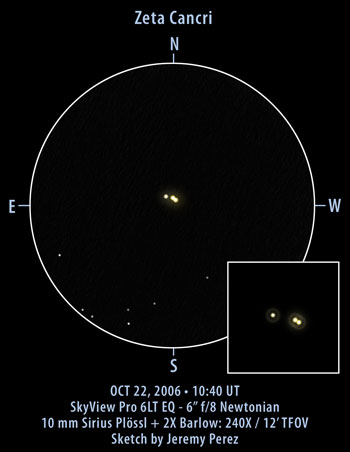
Observation Notes:
This was a great triple star. The central diffraction discs of the A and B components appeared to just touch at a position angle of about 68 degrees, which works out to a separation of about .9 arc seconds. These 2 stars were pale yellow in color and seemed so close in magnitude that I couldn’t tell which was the primary (which meant a PA of either 68 or 248 degrees until I researched the correct designation of primary). The third star appeared fainter, paler yellow, and at a position angle of 75 degrees. It was separated from the B star by about 4 diffraction ring radii, which works out to a separation from the A star of about 6 arc seconds. Actual values can be seen in the table below.
It appears that the A and B stars have a fairly fast orbital period with a PA of 152.7 degrees in 1991, 110.9° in 1998, and my estimate of 68 degrees in 2006
| Subject | Zeta Cancri (STF 1196) |
| Classification | Multiple Star |
| Position (J2000) | [RA: 08:12:12.7 / Dec: +17:38:52]* |
| Position Angle* | AB=152.7° (1991) AB=110.9° (1998) AC=78° (1991) |
| Separation* | AB=.92″ (1991) AB=.7″ (1998) AC=6.17″ |
| Magnitudes* | A=5.3; B=6.2; C=5.9 |
| Spectral Types* | A=F8V; B=F9V; C=G5V |
| Date/Time | OCT 22, 2006 – 3:40 AM MST (OCT 22, 2006 – 10:40 UT) |
| Observing Loc. | Cinder Hills Overlook, Sunset Crater National Monument, AZ |
| Instrument | Orion SVP 6LT Reflector (150 mm dia./1200 mm F/L) |
| Eyepieces/Mag. | 10 mm + 2X Barlow (240X) |
| Conditions | Clear, calm |
| Seeing | 5/10 |
| Transparency | NELM Mag 6.8+ |
| References | The Washington Visual Double Star Catalog, 1996.0 (Worley+, 1996), Tycho Double Star Catalogue (TDSC) (Fabricius+ 2002), Double stars measurements (Alzner 1998), and Spectrophotometric Catalogue of Stars (Kharitonov+, 1988) via VizieR |
*Based on published data.